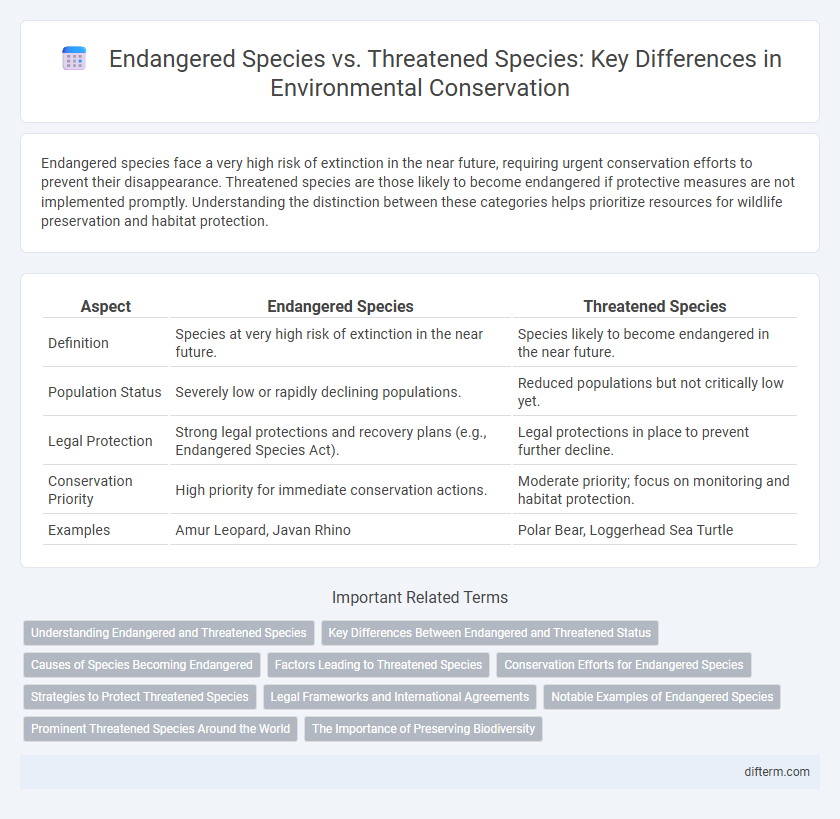Endangered species face a very high risk of extinction in the near future, requiring urgent conservation efforts to prevent their disappearance. Threatened species are those likely to become endangered if protective measures are not implemented promptly. Understanding the distinction between these categories helps prioritize resources for wildlife preservation and habitat protection.
Table of Comparison
| Aspect | Endangered Species | Threatened Species |
|---|---|---|
| Definition | Species at very high risk of extinction in the near future. | Species likely to become endangered in the near future. |
| Population Status | Severely low or rapidly declining populations. | Reduced populations but not critically low yet. |
| Legal Protection | Strong legal protections and recovery plans (e.g., Endangered Species Act). | Legal protections in place to prevent further decline. |
| Conservation Priority | High priority for immediate conservation actions. | Moderate priority; focus on monitoring and habitat protection. |
| Examples | Amur Leopard, Javan Rhino | Polar Bear, Loggerhead Sea Turtle |
Understanding Endangered and Threatened Species
Endangered species face a very high risk of extinction in the near future due to rapid population decline or habitat loss, while threatened species are likely to become endangered if protective measures are not implemented. The International Union for Conservation of Nature (IUCN) classifies these species based on factors like population size, habitat quality, and the rate of decline. Effective conservation strategies require accurate identification and monitoring of both endangered and threatened species to prioritize efforts and allocate resources efficiently.
Key Differences Between Endangered and Threatened Status
Endangered species face a very high risk of extinction in the near future, while threatened species are likely to become endangered if protective measures are not implemented. The International Union for Conservation of Nature (IUCN) categorizes species based on population size, habitat quality, and decline rate, with endangered species typically showing more significant drops in these factors. Conservation efforts prioritize endangered species due to their critical vulnerability, whereas threatened species require monitoring to prevent further decline.
Causes of Species Becoming Endangered
Habitat destruction, primarily due to deforestation and urban expansion, remains the leading cause of species becoming endangered, drastically reducing natural living spaces and food resources. Pollution, including chemical contaminants and plastic waste, further disrupts ecosystems and weakens the health and reproductive capabilities of vulnerable wildlife populations. Overexploitation through poaching and unsustainable hunting practices accelerates decline, pushing many species from threatened to endangered status.
Factors Leading to Threatened Species
Habitat loss due to deforestation and urbanization remains a primary factor leading to species being classified as threatened. Pollution, climate change, and invasive species also significantly disrupt ecosystems, causing declines in population viability. Overexploitation through hunting and trade further exacerbates the vulnerability of these species, pushing many closer to endangerment.
Conservation Efforts for Endangered Species
Conservation efforts for endangered species prioritize habitat restoration, anti-poaching measures, and breeding programs to prevent extinction, addressing critical population declines. Threatened species receive monitoring and habitat protection to avoid slipping into endangered status, but endangered species require more intensive interventions due to their higher risk of extinction. International agreements like CITES and organizations such as the IUCN focus resources on endangered species to stabilize and recover dwindling populations.
Strategies to Protect Threatened Species
Implementing habitat restoration and creating protected areas are essential strategies to safeguard threatened species from further decline. Enforcing legal regulations such as the Endangered Species Act prevents poaching and illegal trade, while community-based conservation promotes sustainable coexistence. Monitoring population trends and promoting breeding programs enhance species recovery and resilience in changing ecosystems.
Legal Frameworks and International Agreements
Endangered species receive stronger protection under legal frameworks such as the U.S. Endangered Species Act and CITES Appendix I, which prohibit or severely restrict exploitation and trade. Threatened species are often covered under less stringent categories, like CITES Appendix II, allowing regulated trade to prevent escalation to endangerment. International agreements such as the Convention on Biological Diversity promote cooperation among nations to monitor and preserve both endangered and threatened species through habitat preservation and sustainable management policies.
Notable Examples of Endangered Species
Notable examples of endangered species include the Amur leopard, Javan rhino, and Vaquita, all facing critically low population numbers due to habitat loss and poaching. Unlike threatened species, which are likely to become endangered in the near future, endangered species require immediate conservation efforts to prevent extinction. Protecting biodiversity hotspots such as the Amazon rainforest and coral reefs is crucial for preserving these vulnerable species.
Prominent Threatened Species Around the World
Prominent threatened species include the Amur Leopard, Javan Rhino, and Vaquita, each facing habitat loss, poaching, and climate change pressures. These species are categorized as threatened due to declining population trends, whereas endangered species have reached a higher risk of extinction in the near future. Conservation efforts targeting these threatened species emphasize habitat protection, anti-poaching measures, and population monitoring to prevent escalation to endangered status.
The Importance of Preserving Biodiversity
Endangered species face imminent risk of extinction, while threatened species are likely to become endangered in the near future, making both critical indicators of ecosystem health. Preserving biodiversity ensures the stability of ecosystems, supports essential services like pollination and water purification, and maintains genetic diversity necessary for species adaptation. Conserving these vulnerable species safeguards ecological balance and underpins global environmental sustainability.
endangered species vs threatened species Infographic

 difterm.com
difterm.com